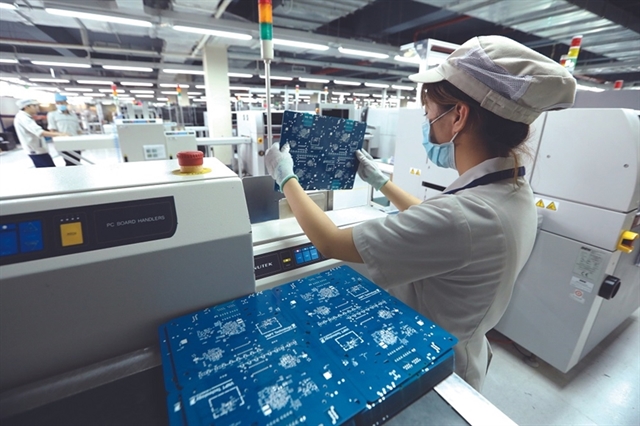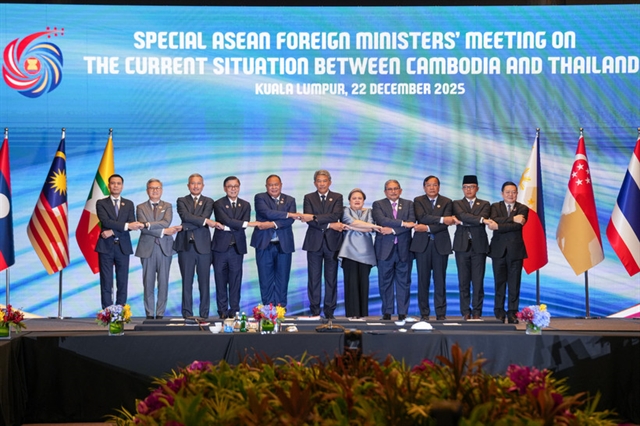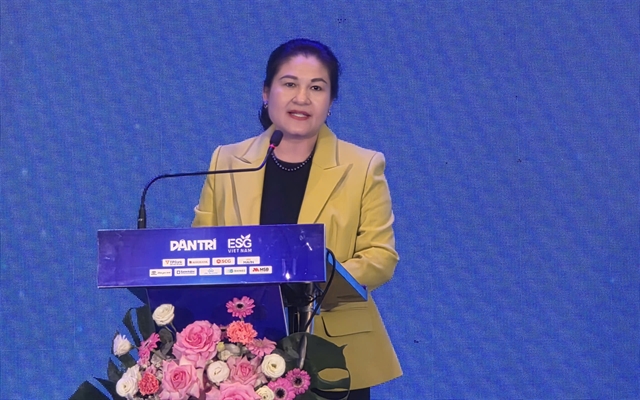 Sunday/Weekend
Sunday/Weekend
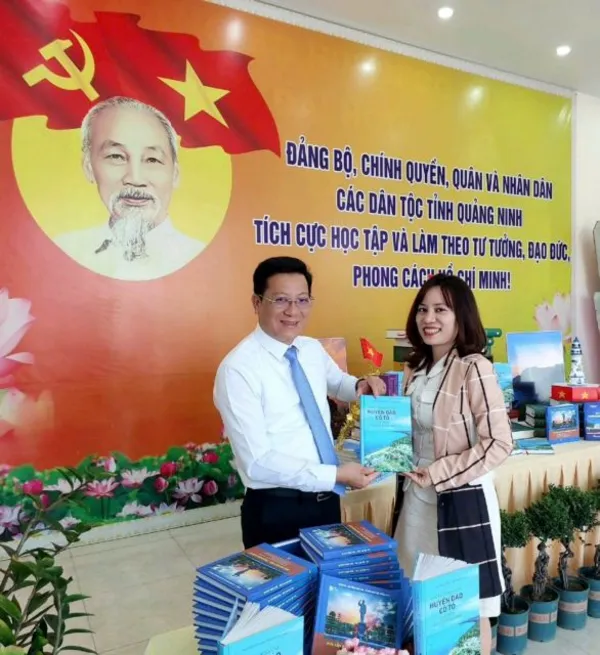
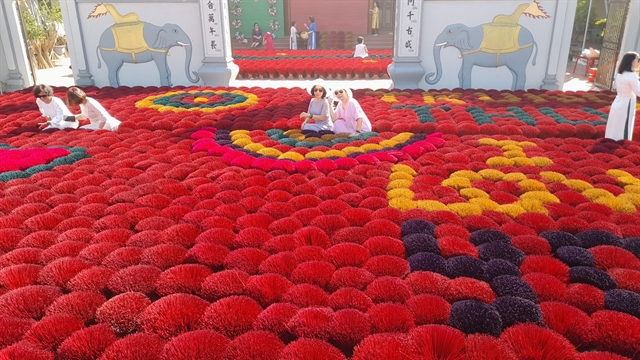 |
| Visitors pose for photos among colourful incense stick "bouquets" in Quảng Phú Cầu Village. — VNS Photo Thanh Nga |
By Thanh Nga
On the southwestern outskirts of Hà Nội, lies a village that has captivated the senses of countless visitors with its enchanting aroma and centuries-old craft.
Quảng Phú Cầu incense-making village in Ứng Hòa District, some 35 kilometres from central Hà Nội, renowned for its joss sticks, has become a beacon for those seeking an olfactory journey into Việt Nam's cultural heritage. Here, the air is filled with the distinct scent of herbal fragrances carefully crafted to perfection, while the diligent hands of skilled artisans bring to life a timeless craft.
As we walked through the village roads, we witnessed a bustling scene with large and small vehicles coming in and out to transport incense sticks for sale. Everywhere we looked, there were spacious yards filled with colourful incense stick "bouquets", resembling giant flowers basking in the sunlight. The villagers make use of their own home yards, communal spaces, and vacant lots to dry incense sticks, creating a captivating sight.
According to the local elders, the craft of making incense originated in Quảng Phú Cầu around 100 years ago. It began in Phú Lương Thượng Hamlet and gradually expanded to include other hamlets in the commune, such as Xà Cầu, Quảng Nguyên, Phú Lương and Đạo Tú.
"Quảng Phú Cầu Village has a history of over a hundred years in incense making. Our ancestors have been engaged in this craft since then. The distinctive characteristic of Quảng Phú Cầu's incense is that it contains no chemicals," Nguyễn Đình Đảm, chief of Cầu Bầu Village, told Việt Nam News.
Initially, joss sticks making in the village was merely a side job done during leisure time between crops. However, due to increasing demand for incense for religious purposes, it developed into a thriving industry, becoming the primary occupation for 70 per cent of households in the village. It now serves as the main source of income for nearly 3,000 households, bringing them an average daily income ranging from VNĐ300,000 to VNĐ500,000 (US$12-20).
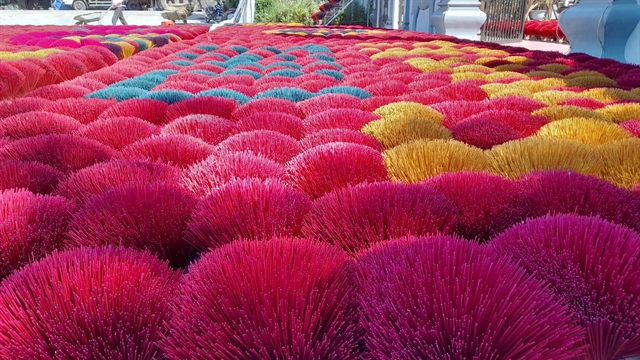 |
| Bunches of colourful bamboo sticks in Quảng Phú Cầu Village. — VNS Photo Thanh Nga |
"My family has been in this craft for 60 years. In the past, my grandparents and parents used to do it manually, splitting bamboo tubes to make thin sticks and covering them with perfumed paste that burn slowly and smell pleasant. But nowadays, we rely entirely on machinery and a different set of materials," Trần Thị Minh, a local incense stick maker, said:
Quảng Phú Cầu Village is the only incense producer left in Hà Nội, and it is one of the largest suppliers of bamboo sticks for other producers in various provinces in the country.
Moreover the village has also exported bamboo sticks to incense producers India, Indonesia and Malaysia.
"In the past, we used to sell thousands of tonnes of bamboo sticks per day, but after the COVID-19 pandemic, sales have decreased to an average of around 100 tonnes a day," Minh added.
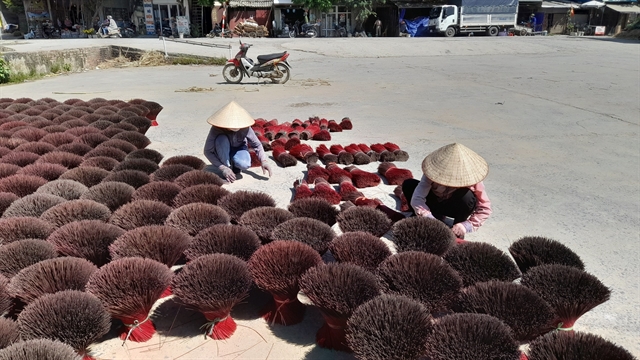 |
| Bunches of bamboo sticks are dried in Quảng Phú Cầu Village. — VNS Photo Thanh Nga |
According to Minh, the process of making joss sticks involves several steps: splitting bamboo into slender sticks, drying them, using a machine to form them round, and then polishing them with another machine.
The best incense sticks come from vầu trees, a type of big bamboo, which is sourced from Thanh Hóa, Nghệ An, and Laos.
The most sophisticated step is to concord a perfumed paste and roll it around the bamboo sticks that could burn very slowly and smell pleasant.
Quảng Phú Cầu artisans always work with great care and attention to detail, especially when it comes to selecting natural substances for making the aromatic paste. This profession has a spiritual element to it, as incense is not only a significant aspect of oriental culture but also a vital source of income for many people.
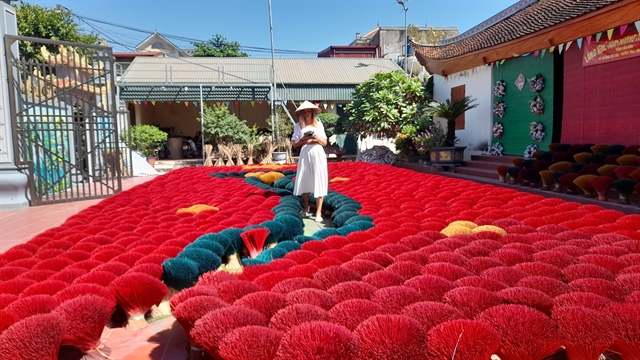 |
| The village has many selfie spots for both domestic and foreign visitors. — VNS Photo Thanh Nga |
Fragrant incense
Quảng Phú Cầu also boasts traditional incense production facilities. The village's incense products are renowned for their natural herbal scent and absence of chemicals.
"In our village, many families are making incense sticks. My family has been in this business for 25 years. In my opinion, the key to making high-quality incense lies in blending various kinds of fragrant powder in a proper ratio to make scented paste to cover the bamboo sticks that burn slowly and smell fragrant," artisan Lê Thị Đông said.
"Our incense products are 100 per cent pure. We use 28 medicinal herbs, including anise, cinnamon, and cloves, to create perfumed paste. In a typical day, my family workshop produces close to 500kg of joss sticks, generating a monthly income of VNĐ10-15 million per worker," Đông added.
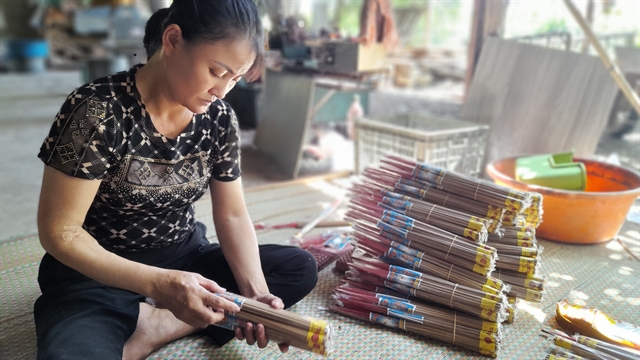 |
| Lê Thị Đông and her incense sticks. — VNS Photo Thanh Nga |
In addition the incense village of Quảng Phú Cầu has made significant efforts to enhance product quality, establish its own brands, and incorporate technology to improve its offerings. Many local products have received certification with the three-star OCOP standard and have received positive feedback from numerous customers.
Tourism development
Thanks to its striking beauty with vibrant colours and captivating fragrance, as well as the warm hospitality of the locals, Quảng Phú Cầu has become a popular destination for both domestic and international tourists.
"In recent years, the growth of the tourism industry has improved the living conditions of craft villages around Hà Nội and provided opportunities for the residents to enhance their economic wellbeing. I have visited many localities and noticed that many villagers have left for work in large cities. However, this village still maintains a vibrant population and an authentic craft atmosphere, which is truly inspiring," said Vũ Thị Thanh Hương, a Hanoian tourist.
Japanese tourist Hitomi Fujiyama expressed great interest in visiting the area, saying, "I discovered this place through Instagram. It is incredibly beautiful."
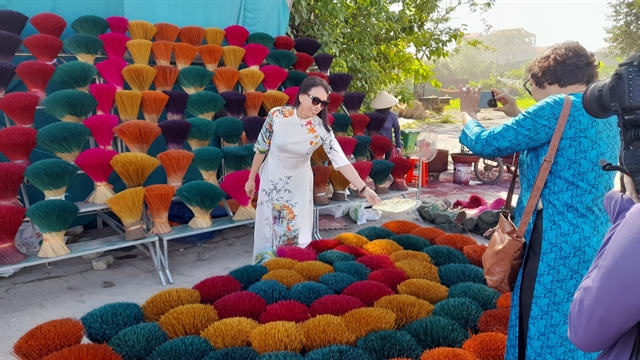 |
| Quảng Phú Cầu Village attracts many tourists to explore and take colourful photos. — VNS Photo Thanh Nga |
Nguyễn Hoài, another tourist, shared her impression of the vibrant ambience of this craft village: "I have had the opportunity to visit many traditional craft villages, but I have rarely been to a place as beautiful and outstanding as Quảng Phú Cầu. When talking about incense making, I often think of Huế, but coming here, it feels like a poetic corner of Huế is embraced within the neighbourhood of Hà Nội," she said.
Earlier this year, authorities made efforts to draw in more tourists to the village.
"Since February 25 this year, the village has been developed as a tourist destination under the guidance of the Ứng Hòa District People's Committee and the Quảng Phú Cầu Commune People's Committee. We are seeking solutions for further development of tourism for this craft village," said Đảm, chief of Cầu Bầu Village. VNS
 |
| A Quảng Phú Cầu villager is drying joss sticks ,. — VNS Photo Lyly Cao |

